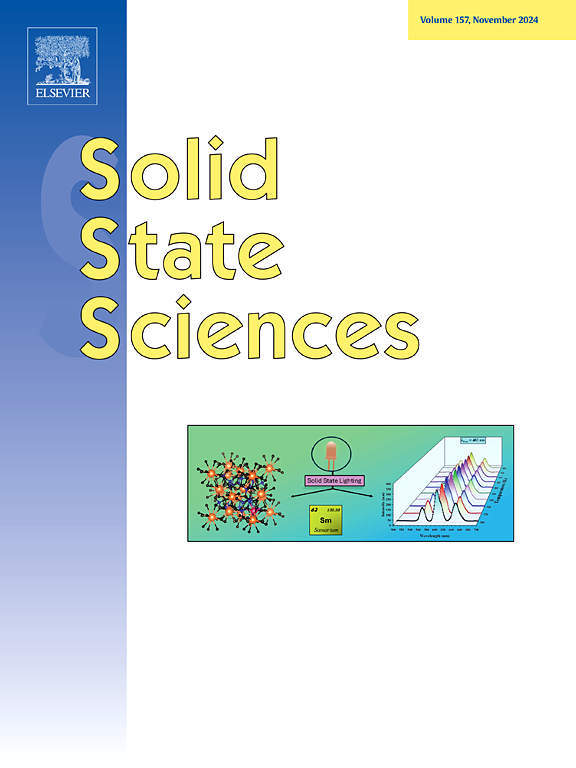Rb2HSc(IO3)6 -具有结构单元[M(IO3)6]的碘酸盐家族新成员
IF 3.3
3区 化学
Q2 CHEMISTRY, INORGANIC & NUCLEAR
引用次数: 0
摘要
采用水热法制备了新化合物Rb2HSc(IO3)6。根据x射线单晶衍射数据,化合物在三斜空间群P-1中结晶,晶胞参数为a = 7.7390(5) Å, b = 7.7362(5) Å, c = 7.7634(6) Å, α = 97.197(5) o, β = 98.193(5) o, γ = 98.787(5) o,热分析表明其在430℃以下稳定。并用红外光谱和EDX分析对化合物进行了表征。DFT计算预测了Rb2HSc(IO3)6的宽间隙半导体行为,并建立了IO3-和sco6单元之间的共价相互作用的键合模式,伴随着这些单元与铷阳离子的离子相互作用。Rb2HSc(IO3)6被认为是A3M(IO3)6家族中的一个新阶段,并与其他家族代表进行了比较,介绍和讨论了其结构特征。基于晶体学和计算的考虑,讨论了Rb2HSc(IO3)6形成不同晶型的可能性。本文章由计算机程序翻译,如有差异,请以英文原文为准。
![Rb2HSc(IO3)6 – a new member of the iodate family with a structural unit [M(IO3)6]](https://img.booksci.cn/booksciimg/2025-6/102304976651781871661.jpg)
Rb2HSc(IO3)6 – a new member of the iodate family with a structural unit [M(IO3)6]
The new compound Rb2HSc(IO3)6 was prepared by the hydrothermal method. According to the single-crystal X-ray diffraction data, the compound crystallizes in the triclinic space group P-1, with the cell parameters a = 7.7390(5) Å, b = 7.7362(5) Å, c = 7.7634(6) Å, α = 97.197(5) o, β = 98.193(5) o, γ = 98.787(5) o. Thermal analysis shows it to be stable up to 430 °C. The compound was also characterized by the IR spectroscopy and EDX analysis. DFT calculations predict wide-gap semiconducting behavior for Rb2HSc(IO3)6 and establish a bonding pattern of covalent interactions within IO3- and ScO6-units, accompanied by ionic interactions of these units with rubidium cations. Rb2HSc(IO3)6 is considered a new phase in the A3M(IO3)6 family and its structural features are presented and discussed in comparison with other family representatives. Based on the crystallographic and computational considerations, the possibility for Rb2HSc(IO3)6 to form different polymorphs is also discussed.
求助全文
通过发布文献求助,成功后即可免费获取论文全文。
去求助
来源期刊

Solid State Sciences
化学-无机化学与核化学
CiteScore
6.60
自引率
2.90%
发文量
214
审稿时长
27 days
期刊介绍:
Solid State Sciences is the journal for researchers from the broad solid state chemistry and physics community. It publishes key articles on all aspects of solid state synthesis, structure-property relationships, theory and functionalities, in relation with experiments.
Key topics for stand-alone papers and special issues:
-Novel ways of synthesis, inorganic functional materials, including porous and glassy materials, hybrid organic-inorganic compounds and nanomaterials
-Physical properties, emphasizing but not limited to the electrical, magnetical and optical features
-Materials related to information technology and energy and environmental sciences.
The journal publishes feature articles from experts in the field upon invitation.
Solid State Sciences - your gateway to energy-related materials.
 求助内容:
求助内容: 应助结果提醒方式:
应助结果提醒方式:


